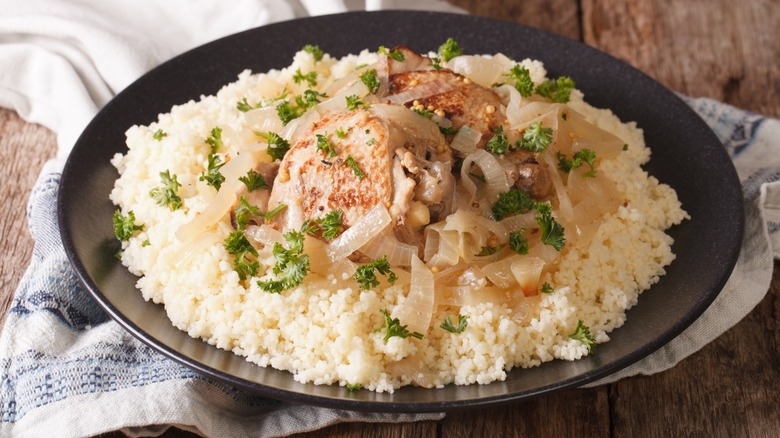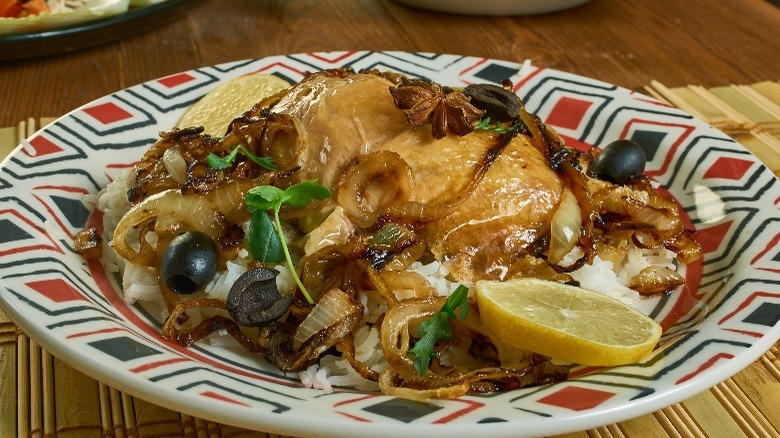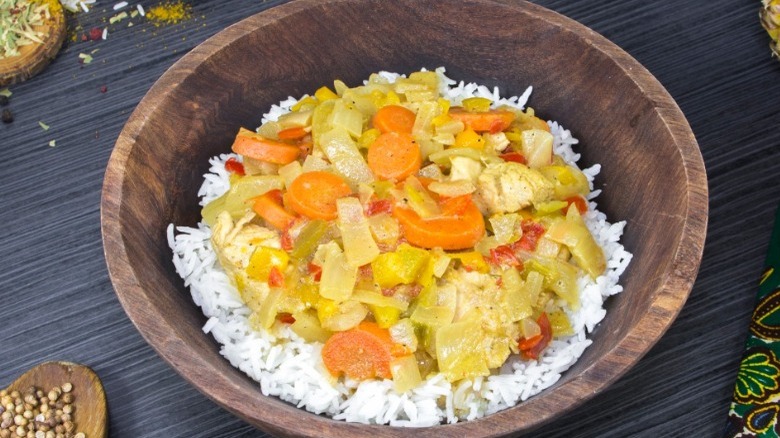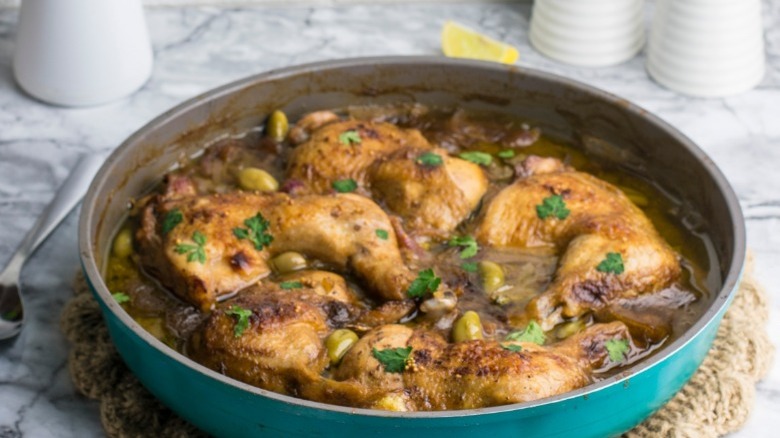Chicken Yassa: The Senegalese Chicken Dish With A Citrusy-Sweet Kick
Exploring the favored dishes of another country can help to expand our own world, giving us quite literally the taste of culture. While a taste is not representative of an entire people or place and its rich history, those first indoctrinating flavors help to build connection and understanding where cultural, language, or other barriers may exist. In this way, food becomes its own unique language, one that speaks to us intimately, sharing secrets of the people and places from which it was born. For the less adventurous among us, fear of the unknown can be too great a hurdle, and this first heady introduction is never made. The solution is to find a dish with ingredients you're familiar with, an easy entry point to grow your palate and unravel the mysteries, ingredients, and flavors of a culture.
According to award-winning culinary historian and journalist Jessica B. Harris, when it comes to West African cuisine, poulet Yassa (chicken yassa, yassa au poulet, or yassa ganar) is just that kind of dish. Harris shared with Today that she calls it her "totemic dish" because of its ability to seemingly transcend cultural food bias and has included a recipe for it in nearly every cookbook she has written. "I describe it as a connector of the familiar and unfamiliar: the dish that speaks to that kind of invisible — but sometimes intuited — umbilicus between the African continent and the American hemisphere," says Harris.
So what is chicken yassa?
Chicken yassa may best be described as Senegalese comfort food. It is a popular traditional chicken dish from the Casamance region of Senegal (south of Gambia) in West Africa. It is richly flavored, bright with lemon, and redolent with the sweet scent of caramelized onions. The chicken is cooked down in the onions until it is juicy and fall-apart tender with just enough heat from Scotch bonnet or habanero peppers to keep you coming back for more. In a video on Today, Jessica B. Harris (who specializes in the food of the African diaspora) shares what she believes makes the dish so accessible is that lemons, onions, and chicken are ingredients that we're all familiar with and what Harris refers to as, "non-threatening."
According to travel writer Julia Hammond (who notes that the fertile soil of the Casamance region is perfect for growing both lemons and onions), yassa is a communal dish that is meant to be shared with family and friends and is often served in a large bowl, accompanied by rice (via Discoverer).
The history of chicken yassa
Senegal draws food-spiration from its varied culinary influences; chicken yassa is no different. It was a product of Senegal's very long French occupation from 1659 to 1960. During that time, the two cultures shared much with each other, and soon French and Senegalese cooking techniques were combined, marrying the region's flavors. As chef and owner of West African restaurant, Teranga in Harlem, Pierre Thiam puts it, "In Senegal, cooking is a celebration of how we have gloriously melded the old with the new, the native with the global." (via Edible DC)
Yassa is also commonly made with lamb or fish instead of chicken. Though all three dishes are primarily served with rice (according to Harris, more traditionally "broken rice") in Senegal, variations include serving it atop couscous or a traditional West African grain called fonio (via Serious Eats). CultureTrip reports that yassa is now so popular it's even become a street-food trend, spilling its spicy, lemon-tinged caramelized onions out of the ends of baguettes outside football stadiums and beachside.
Chicken yassa ingredients
The key ingredients in yassa's stewed chicken dish are onions, lemon juice, Scotch bonnet or habanero peppers, and chicken. Depending on the cook, your chicken parts may vary. For Chef Pierre Thiam, skin-on, bone-in chicken legs are a must, while Jessica B. Harris prefers a whole cut-up chicken (bone-in and skin-on), and Chef Lola Kitchen's recipe for poulet au yassa calls for chicken thighs only. It's important to note, though, that to achieve the depth of flavor and moisture required of the dish, most recipes call for the addition of dark meat or chicken with its skin-on. As Discoverer advises, a free-range chicken is preferred, as it closely mimics the traditions of the dish, using what is considered best for flavor and referred to as poulet bicyclette or bicycle chicken (which just means free-roaming).
Like many recipes, chicken yassa's ingredients change from cook to cook, with some adding carrots and olives to the mix to create a "fancied up yassa," as Harris does, or by adding ginger as Chef Lola prefers. Most recipes contain a bit of dijon mustard (that French influence). Some throw in green bell peppers or change the lemon to a lime. Most use fresh ground pepper, garlic, bay leaf, and peanut oil. But the real key to this recipe's popularity is undoubtedly the onions — caramelized and sweet but tamed and balanced by the tartness of lemon and the heat of the peppers; they are not-to-be-missed and should not be substituted.
How to make chicken yassa
Making chicken yassa is both simple and time-consuming. The ingredient list is short, and the individual cooking techniques are relatively simple, but to achieve chicken yassa's depth of flavor, you must undertake a three-step process that includes: marinating, grilling (or browning if you don't have a grill pan), and then cooking it all down. While this requires a bit of time to complete, with a little careful planning, you'll be tucked into a succulent dish of yassa before you know it. Harris recommends marinating your chicken with lemon juice, onions, salt, pepper, minced habanero, and peanut oil the night before to infuse the flavors and save time, but you can shorten that time to two hours if you're in a hurry. (via Today) When it comes time to cook, grill your chicken on both sides until browned but not cooked through. Remove the chicken from the pan, add peanut oil and onions, and sauté the onions until caramelized. Add the rest of your ingredients along with the chicken to the pan (including any herbs and spices, carrots, olives, peppers, etc.), combine it with any leftover marinade and chicken broth or water, and allow it all to cook down and the flavors to meld for 30 minutes or so until done (via The New York Times).
Na rees ak jàmm! (*"Cheers!" in Wolof, the most widely spoken language in Senegal via ST Communications).




